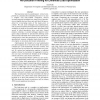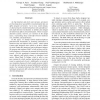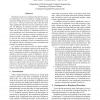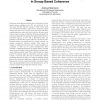ISCA
2005
IEEE
14 years 8 months ago
2005
IEEE
The load-store unit is a performance critical component of a dynamically-scheduled processor. It is also a complex and non-scalable component. Several recently proposed techniques...
ISCA
2005
IEEE
14 years 8 months ago
2005
IEEE
As chip densities and clock rates increase, processors are becoming more susceptible to transient faults that can affect program correctness. Up to now, system designers have prim...
ISCA
2005
IEEE
14 years 8 months ago
2005
IEEE
Writing concurrent programs is difficult because of the complexity of ensuring proper synchronization. Conventional lock-based synchronization suffers from wellknown limitations, ...
ISCA
2005
IEEE
14 years 8 months ago
2005
IEEE
As processor speeds increase and memory latency becomes more critical, intelligent design and management of secondary caches becomes increasingly important. The efficiency of curr...
ISCA
2005
IEEE
14 years 8 months ago
2005
IEEE
Sensor network processors and their applications are a growing area of focus in computer system research and design. Inherent to this design space is a reduced processing performa...
ISCA
2005
IEEE
14 years 8 months ago
2005
IEEE
Significant time is spent by companies trying to reproduce and fix the bugs that occur for released code. To assist developers, we propose the BugNet architecture to continuousl...
ISCA
2005
IEEE
14 years 8 months ago
2005
IEEE
ISCA
2005
IEEE
14 years 8 months ago
2005
IEEE
Runahead execution is a technique that improves processor performance by pre-executing the running application instead of stalling the processor when a long-latency cache miss occ...
ISCA
2005
IEEE
14 years 8 months ago
2005
IEEE
RENO is a modified MIPS R10000 register renamer that uses map-table “short-circuiting” to implement dynamic versions of several well-known static optimizations: move eliminat...
ISCA
2005
IEEE
14 years 8 months ago
2005
IEEE
It has been shown that many requests miss in all remote nodes in shared memory multiprocessors. We are motivated by the observation that this behavior extends to much coarser grai...





